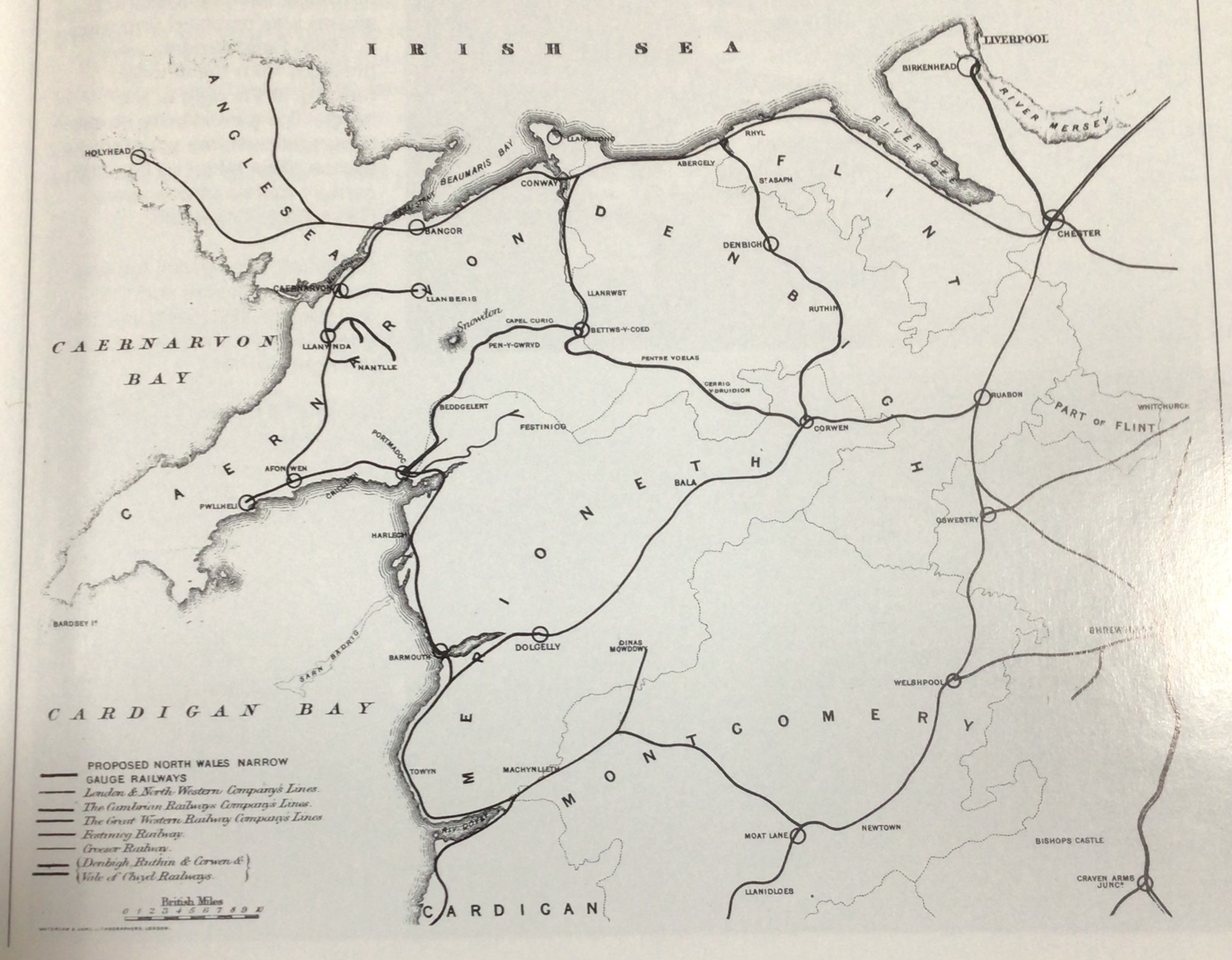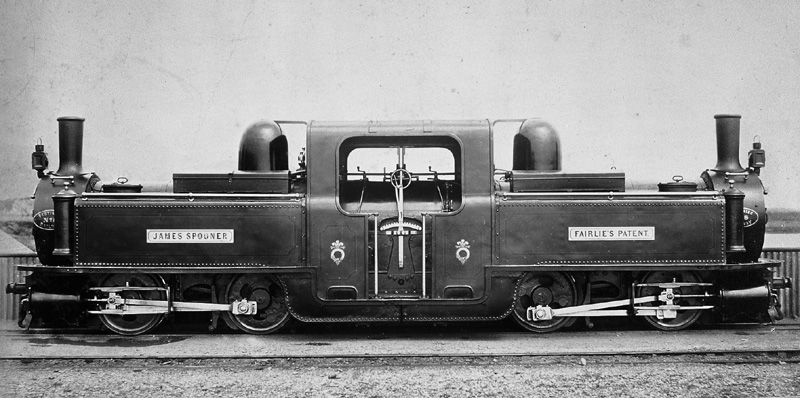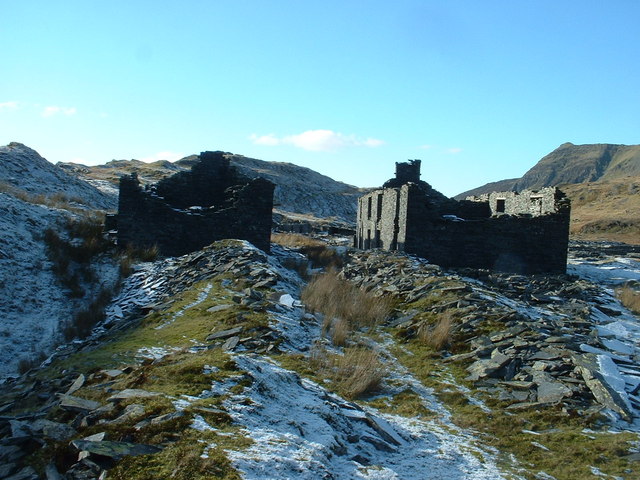|
Hugh Beaver Roberts
Hugh Beaver Roberts (c. 1820 - 1903) was a solicitor, originally based in Bangor, Gwynedd, Bangor, Caernarfonshire who became an entrepreneur involved in the construction of narrow gauge railways and the ownership of slate quarries in North Wales during the second half of the 19th century. Personal life Hugh Beaver Roberts was born in Cilcain, a village near Mold, Flintshire, Mold in Flintshire. He was the second son of Hugh Roberts, and received his education at Rugby School. He then moved to Bangor, Gwynedd, Bangor where he was a solicitor, working with John Hughes. Hughes died in 1849, and Roberts took over his legal practice, as well as succeeding his as Clerk to the Bangor Magistrates, Diocesan Registrar, Chapter CLerk and agent to the Bishop of Bangor. His marriage to Harriet Wyatt of Llandygai took place in June 1848, after which they lived at Bryn Menai in Bangor. They had five children, three sons and two daughters. They briefly moved to the Plas Madoc estate at Llanddoged ... [...More Info...] [...Related Items...] OR: [Wikipedia] [Google] [Baidu] |
Bangor, Gwynedd
Bangor (; ) is a City status in the United Kingdom, cathedral city and Community (Wales), community in Gwynedd, north Wales. It is the oldest city in Wales. Historic counties of Wales, Historically part of Caernarfonshire, the community had a population of 15,060 at the 2021 United Kingdom census, 2021 census, and the built up area had a population of 16,990. Landmarks include Bangor Cathedral, Bangor University and Garth Pier. The Britannia Bridge, Britannia and Menai Suspension Bridge, Menai Suspension bridges connect the city to the Anglesey, Isle of Anglesey. History The origins of the city date back to the founding of a monastic establishment on the site of Bangor Cathedral by the Celtic saint Deiniol in the early 6th century AD. itself is an old Welsh word for a wattled enclosure, such as the one that originally surrounded the cathedral site. The present cathedral is a somewhat more recent building and has been extensively modified throughout the centuries. While the ... [...More Info...] [...Related Items...] OR: [Wikipedia] [Google] [Baidu] |
Croesor Tramway
The Croesor Tramway was a Wales, Welsh, narrow gauge railway line built to carry slate from the Croesor slate mines to Porthmadog. It was built in 1864 without an act of Parliament and was operated using horse power. The tramway was absorbed into the Croesor and Port Madoc Railway in 1865 and later became the Portmadoc, Croesor and Beddgelert Tram Railway in 1879. Part of its route, from Croesor Junction to Porthmadog, was taken over by the Welsh Highland Railway in 1922, and upgraded to allow the operation of steam locomotives. The remainder of the line continued as a horse-drawn tramway, and operated as such until the mid-1940s. History slate industry, Slate quarrying in the remote Cwm Croesor (Croesor valley) dates back to at least 1846 when the Croesor Quarry opened. Quarrying expanded in the early 1860s and transportation to the shipping wharfs at Porthmadog became a limiting factor. In 1862 discussion began to construct a tramway to connect the valley with the sea. An i ... [...More Info...] [...Related Items...] OR: [Wikipedia] [Google] [Baidu] |
Beddgelert
Beddgelert () is a village and community (Wales), community in the Snowdonia area of Gwynedd, Wales. The population of the community taken at the 2021 United Kingdom census, 2021 census was 460 (rounded to the nearest 10). This includes Nantmor and Nant Gwynant. It is reputed to be named after the legendary hound Gelert. The community is large and sparsely populated and covers 86 square kilometres. Location The village stands in a valley at the confluence of the Afon Glaslyn, River Glaslyn and the Afon Colwyn. Just above the confluence of the rivers, in the centre of the village, is an old stone bridge with two arches. Many of the houses and hotels are built of local dark stone. To the west is Moel Hebog and to the north and a series of hills rising to the Snowdon horseshoe. The A4085 road, A4085 between Caernarfon ( north) and Porthmadog ( south) runs through the village. The outdoor equipment company Gelert (company), Gelert originated in Bryncir then moved to Beddge ... [...More Info...] [...Related Items...] OR: [Wikipedia] [Google] [Baidu] |
Waunfawr
Waunfawr (''gwaun'' + ''mawr'', ") is a village and community, SE of Caernarfon, near the Snowdonia National Park, Gwynedd, in Wales. Description Waunfawr is in the Gwyrfai valley, on the A4085 road from Caernarfon to Beddgelert. It contains the Waunfawr railway station on the Welsh Highland Railway between Caernarfon and Porthmadog. Waunfawr was historically part of the parish of Llanbeblig, which also included the borough of Caernarfon. The Local Government Act 1894 directed that parishes could no longer straddle borough boundaries, and so the part of the parish of Llanbeblig outside the borough of Caernarfon was made a separate parish called Waenfawr. The official spelling was changed from Waenfawr to Waunfawr in 1957. Rural parishes such as Waunfawr were converted into communities in 1974 under the Local Government Act 1972. The community had a population of 1,427 at the 2011 census. According to the United Kingdom Census 2011, the percentage of Welsh language speaker ... [...More Info...] [...Related Items...] OR: [Wikipedia] [Google] [Baidu] |
London And North Western Railway
The London and North Western Railway (LNWR, L&NWR) was a British railway company between 1846 and 1922. In the late 19th century, the LNWR was the largest joint stock company in the world. Dubbed the "Premier Line", the LNWR's main line connected four of the largest cities in England; London, Birmingham, Manchester and Liverpool, and, through cooperation with their Scottish partners, the Caledonian Railway also connected Scotland's largest cities of Glasgow and Edinburgh. Today this route is known as the West Coast Main Line. The LNWR's network also extended into Wales and Yorkshire. In 1923, it became a constituent of the London, Midland and Scottish (LMS) railway, and, in 1948, the London Midland Region of British Railways. History The company was formed on 16 July 1846 by the ( 9 & 10 Vict. c. cciv), which authorised the amalgamation of the Grand Junction Railway, London and Birmingham Railway and the Manchester and Birmingham Railway. This move was prompted, in ... [...More Info...] [...Related Items...] OR: [Wikipedia] [Google] [Baidu] |
North Wales Narrow Gauge Railways
The North Wales Narrow Gauge Railways (NWNGR) was a railway company that planned to build a number of inter-connected narrow-gauge railways across North Wales. The first two of these lines – jointly known as the "Moel Tryfan Undertaking" – were authorised by act of Parliament, the (35 & 36 Vict. c. clxxv) and were built and opened in the 1870s. The original main line ran from Dinas railway station, Dinas Junction to Bryngwyn Station, Bryngwyn and opened in 1877. The second line was a branch from Tryfan Junction to Rhyd Ddu railway station, South Snowdon, though shortly after opening, the company designated the Tryfan Junction to Bryngwyn section as the branch, and the Dinas Junction to South Snowdon section as the main line. Routes built The company completed construction of two lines, The first, opened in 1877, was approximately long, running south-east from a junction with the London and North Western Railway's Carnarvonshire Railway, Caernarfon to Afon Wen branch at ... [...More Info...] [...Related Items...] OR: [Wikipedia] [Google] [Baidu] |
Charles Easton Spooner
The Spooners of Porthmadog refers to the Spooner family of Porthmadog, North Wales who made important contributions to the development of narrow gauge railways both locally and throughout the world. James Spooner, together with his sons James Swinton and Charles Easton and other members of their family, constructed and managed the Ffestiniog Railway for over fifty years. In North Wales they were involved in the promotion of numerous railway schemes including many quarry lines, the Talyllyn Railway, the Festiniog and Blaenau Railway, the North Wales Narrow Gauge Railways and the Carnarvonshire Railway. Through publications and overseas family commissions they influenced narrow gauge railway construction in Russia, America and throughout the British Empire. James Spooner ;Dates 1790–1856 Family James Spooner was born at Leigh near Worcester in 1790. He trained as a land surveyor and is believed to have worked as a civilian member of an Ordnance Survey team. He married in 18 ... [...More Info...] [...Related Items...] OR: [Wikipedia] [Google] [Baidu] |
Ffestiniog Railway
The Ffestiniog Railway () is a heritage railway based on Narrow-gauge railway, narrow-gauge, located in Gwynedd, Wales. It is a major tourist attraction located mainly within the Snowdonia#Snowdonia National Park, Snowdonia National Park. The railway is roughly long and runs from the harbour at Porthmadog to the Slate industry in Wales, slate mining town of Blaenau Ffestiniog, travelling through forested and mountainous terrain. The line is single track throughout with four intermediate passing places. The first mile of the line out of Porthmadog runs atop an embankment called ''the Cob'', which is the Levee, dyke of the polder known as Traeth Mawr. The Festiniog Railway Company, which owns the railway, is the oldest surviving railway company in the world. It also owns the Welsh Highland Railway, which was re-opened fully in 2011. The two railways share the same track gauge and meet at Porthmadog station, with occasional trains working the entire route from Blaenau Ffestinio ... [...More Info...] [...Related Items...] OR: [Wikipedia] [Google] [Baidu] |
£sd
file:Guildhall Museum Collection- Drusilla Dunford Money Table Sampler 3304.JPG, A Sampler (needlework), sampler in the Rochester Guildhall, Guildhall Museum of Rochester, Medway, Rochester illustrates the conversion between pence and shillings and shillings and pounds. file:Cash register (8058279685) (2).jpg, Old till in Ireland, with "shortcut" keys in various £sd denominations (lower numbers) and their "new pence" equivalent (upper numbers) file:TOY (FindID 748865).jpg, Play money, Toy coin, which teaches children the value of a shilling £sd (occasionally written Lsd, spoken as "pounds, shillings, and pence" or pronounced ) is the popular name for the pre-decimal currency, currencies once common throughout Europe. The abbreviation originates from the Ancient Roman units of measurement, Latin currency denominations , , and . In the British Isles, these were referred to as ''pound sterling, pounds'', ''shillings'', and ''pence'' (''pence'' being the plural of ''penny''). Un ... [...More Info...] [...Related Items...] OR: [Wikipedia] [Google] [Baidu] |
Rhosydd Quarry
Rhosydd quarry was a slate quarry in the Moelwynion, Moelwyn mountains, northeast of Porthmadog in North Wales. Small-scale working of the site began in the 1830s, but was hampered by the remote location, and the lack of a transport system to carry the slates to markets. The Rhosydd Slate Company was formed in 1853, and became a limited company in 1856. Transport was made more difficult by the attitude of the Cwmorthin quarry, through whose land the most obvious route to the Ffestiniog Railway ran. A solution was found in 1864, with the opening of the Croesor Tramway, to which the quarry was connected by one of the longest single-pitch Cable railway, cable-hauled inclines in Wales. Huge amounts of money were spent on development work, and the company, unable to make adequate returns, went into voluntary liquidation in 1873. The quarry was auctioned in 1874, and the New Rhosydd Slate Quarry Company Ltd. was formed. Unlike its predecessor, the directors were all Welsh, and three-q ... [...More Info...] [...Related Items...] OR: [Wikipedia] [Google] [Baidu] |





